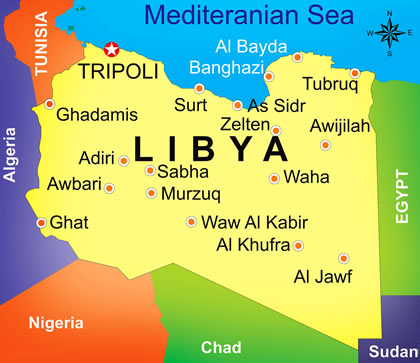 |
| Flag of Libya |
By 1942 the Italians had been defeated, the British occupied Tripolitania and Cyrenaica; and the French occupied Fezzan. In Tripolitania the British retained direct control, but in Cyrenaica they granted greater autonomy; the French administered Fezzan through direct military control.
After the war a number of different solutions were offered regarding the future of the Libyan territories. Italy demanded the return of Libya to its jurisdiction. Other Western nations suggested a trusteeship, while some advocated independence.
Egypt, Libya’s neighbor to the east, was interested in acquiring control over the territory. Competing Libyan political forces also had conflicting goals. Some wanted the continuation of Sayyid Idris’s Sanussi leadership, while a political society of young educated Libyans like Mukhtar pushed for unity and complete independence.
When the powers failed to agree, the matter was turned over to the newly formed United Nations (UN). After protracted negotiations the UN General Assembly recommended in 1949 that Libya—comprising Cyrenaica, Tripolitania, and Fezzan—should constitute a unified state that should obtain independence no later than January 1, 1952. Thus for the first time in its history, the General Assembly acted as a world legislator with binding authority.
 |
| map of Libya |
In 1951 Libya became a unified nation under the monarchy of King Idris. At the time Libya was one of the poorest countries in the world, and Idris relied heavily on Western assistance. He also retained considerable executive power and drew support from tribal leaders, traditional politicians, and a few successful businessmen. This narrow power base alienated many, who grew increasingly disaffected with the old regime. Idris continued to rule Libya until he was overthrown in 1969 by Muammar Qaddafi.
EmoticonEmoticon